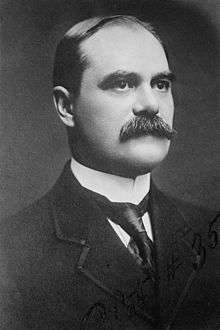William F. Assmann
William F. Assmann (July 1862 – 19 October 1920) was a record setting balloonist.

Biography
He was born in 1862 in St. Louis, Missouri.
In 1910 he ascended to 4,000 feet and traveled 206 miles.[1]
On 17 October 1910, William Assman and Lieutenant Leopold Vogt, of the German Army, took off in the hydrogen-filled "Harburg III", from St. Louis, Missouri, one of ten balloons in the James Gordon Bennett International Balloon Race. At 6:10 pm, 18 October, they crossed into Canada; by 9:00 pm they opted to land as their ballast was getting low, but were over the waters of Georgian Bay, and thus continued onward. Two hours later, in the pitch black of night — having traveled 850 miles from St. Louis, at speeds upwards of 60 miles per hour -- Assman and Vogt, having used up all but 2 ½ sacks of ballast, decided they had no alternative but to put down. They were over Lake Nipissing, Ontario, at 18,000 feet. Lt. Vogt later described to newspaper reporters pulling a valve, and the "Harburg III" plummeting in a “terminal velocity descent”. As the aeronauts were about to be smashed to death on Gull Island, the wind cast their balloon into the lake. Both men were momentarily knocked unconscious by the impact. William Assman’s left arm was broken, and his right hand badly sprained, an artery in the wrist cut. Despite his injuries the men were forced to swim to nearby Gull Island, where they tied the balloon to a tree. For two hours they shouted for assistance, but were far enough out in the lake (which is deep in the Canadian wilderness) that they got no response.
After an all-night stay on the island, soaked and cold from their episode in the lake, Assman bleeding profusely from his cut, the aeronauts were rescued around 6:00 am by two local Native Indians passing by in a canoe. The men were paddled 10 miles to the tiny hamlet of Nipissing Village, south of the railway town of North Bay, Ontario. Assman's injuries were attended to by a local doctor. The "Harburg III" was towed to shore, and transported with its crew to New York by train. A number of the balloon’s instruments were lost, though it’s unknown if they fell in the lake or were pilfered as souvenirs.
The flight of William Assman and Lt. Vogt and their subsequent crash made headlines around the world. They placed fifth in the race.[2][3]
In 1911 he took part in the Kansas City national balloon race in an elimination competition.[4]
He died on 19 October 1920.[5]
References
- "Balloonist Goes 206 Miles. When 4,000 Feet Up Is Struck by a Night Storm. Lands Drenched". New York Times. May 3, 1910. Retrieved 2010-11-07.
After a spectacular flight of 206 miles, In which his balloon was soaked with rain and beaten by hail, William F. Assmann, amateur aeronaut of St. Louis, ... He was traveling at an altitude of 4000 feet when he was struck by a night storm , one of the things most feared by aeronauts.
- St. Louis Despatch newspaper articles, 17, 18, 19, 20 and 21 October 1910
- New York Times articles, 20 and 21 October 1910
- "7 Balloon Racers Off. National Elimination Contest Begins At Kansas City Five Make Perfect Starts. Not A Serious Accident Mars The Get-Away Of Aeronauts. Pilots Pleased With Northeast Current". Baltimore Sun. July 11, 1911. Retrieved 2010-11-07.
Driven by 15-mile wind from the southwest, seven large gas balloons sailed away from her late today in the national elimination balloon race.
- "Missouri Digital Heritage: Death Records Certificates" (PDF). sos.mo.gov. Retrieved 25 February 2011.
 Assmann circa 1910-1915
Assmann circa 1910-1915 Assmann in 1911 in the "Ms. Sofia" balloon
Assmann in 1911 in the "Ms. Sofia" balloon